More and more organizations are using cloud applications and services for its benefits. Knowledge of information security and risk management preparedness when using the cloud can avoid a major business catastrophe (which not only entails the leakage or loss of sensitive company and client data, but also a huge financial burden).
To reduce the risk of data breach or loss there are at least five things you should do:
- Have a trusted cloud provider.
A business’ cloud provider is the first part of the puzzle. The vendor is providing the service and needs to be the first to take data loss seriously. With a trusted and secure cloud provider an organization knows that at least the vendor’s information security system is safe and prepared for any potential attack or unforeseen event. - Apply and enforce rules and regulations.
Rules may not be fun, but their composition comes as a consequence of previous experiences and incidents caused by disastrous events. Due to their insights and knowledge in the field of information security (thanks to their team of professionals and available resources for research), it is safe to say that the regulatory bodies who create the minimum standards for compliance know what they are talking about (at least for the most part). - Constant information risk assessments.
This type of analysis allows organizations to find out where their security risk and potential liability stand. The assessment provides a thorough check of the people, processes and technology involved in a business’ information security efforts. It’s like going to the doctor on a regular basis; if there’s a problem it gets caught in time, contained, even prevented. - Have a business continuity plan in place.
A business continuity plan is customized to address business and system functions necessary to minimize any disruption of business operations while ensuring that adherence to regulatory compliance mandates are maintained. In turn, this nullifies or at least reduces data loss and financial repercussions. - Be aware of the fundamental pieces involved in information security and risk management.
Awareness is key to preparedness. The leadership of any organization should have a minimum of training in the mechanisms of securing information. Educational sessions on the topic should also take place for all those who work with the company. Without the know-how of the basics, negligence and mistakes on part of business collaborators can take place, defeating the purpose of the efforts taken to ensure a top company risk management plan.
Since organizations use the cloud to store important company information, file sharing applications, peer-to-peer communications, infrastructure applications, and services (such as payments); the information that is at risk is of utmost importance for the continuation of a businesses’ day to day activities.
All it takes is one vulnerable area for disaster to occur. Decrease the chances of a data breach, information deletion, losing business and consequently, suffering financial disaster. Stay informed, use the five tips above, and secure a risk management expert.
There are plenty of options and solutions; it’s only a matter of choosing which one works best for you.
Image Courtesy of FutUndBeidl

